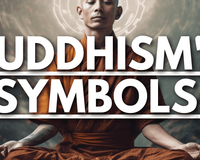The Bodhi Tree - History and Tradition
The Bodhi tree, also known as the Tree of Enlightenment, is where Siddhartha Gautama meditated for 49 days.
After this enlightenment phase, as Buddhists say, Siddhartha became Buddha "The Enlightened One."
Currently, this famous tree is revered as a religious center, belonging to the Moraceae family as a fig species. Today, the tree, said to be where Buddha meditated, resides in Bodhgaya and is a direct descendant of the tree from 2500 years ago.
The Bodhi Tree as a Symbol
The Bodhi tree is known as the tree of life, with its roots representing the origins of all actions—three healthy roots symbolizing love, wisdom, and compassion, while three unhealthy roots symbolize illusion, hatred, and greed.
The trunk of the Bodhi tree symbolizes the forms of things around us, sensations, perception, mental formations, and consciousness; these terms engage people's senses like taste, sight, touch, smell, and hearing, managed by body and mind. Therefore, meditation must center both body and mind.
Read also: Buddhist Symbols and Their Meanings
The leafy branches represent the outcomes of all actions done in life.
By understanding what it symbolizes, one can grasp why things happen to individuals, which is essentially through the decisions they make that shape the moments in a person's life.

What Does the Bodhi Tree Look Like?
In Religion
As Buddhism is more of a philosophy of life, not believing in gods or creators of the universe, it doesn't affect any religion. However, this doesn't mean there are no religions based on Buddhism.
For this reason, the Bodhi tree doesn't negate any religion; it's just an idea of life. Moreover, in regions based on Buddhism, the Bodhi tree is essential for performing various rites or religious ceremonies.
History of the Bodhi Tree
In Buddhism, it's said that Prince Siddhartha Gautama fasted until he could eat the milk and honey offered by a young woman. After this light meal, he sat under the Bodhi tree, where he meditated for 49 days.
Buddha Gautama
The true name of Buddha Gautama is Siddhartha Gautama, who was a prince belonging to the Sakya clan, born in India between 563 and 483 BC. He attained the name Buddha because Siddhartha achieved enlightenment by meditating for 49 days.
The Story of Buddha Guatama
Gautama Buddha was the son of the king of Sakya, a kingdom in the southern Himalayas, with his original name as mentioned above being Siddhartha Gautama.
Siddhartha escaped the palace where he lived to see how his father's subjects suffered from hunger, poverty, and disease.
Seeing all this suffering, Siddhartha wanted to understand what Buddha meant under the life of the tree and what suffering was due to. So, at 29 years old, he fled home to seek answers to his doubts.
But Gautama never found the answers to his doubts and only suffered from hunger to no avail. Then he met a young woman who offered him milk and honey to regain his strength.
After eating, he sat under a fig tree where he meditated for several weeks and understood the meaning of life. After that, he taught his learning and shared his knowledge.
Importance of Buddha Guatama
Buddha Guatama is significant because his teachings have endured over time, not only because he is one of the people who attained enlightenment, but also because even today's sun preserves and practices their beliefs.
The stories and discourses of Buddha Guatama, which have become important documents for Buddhism, are still preserved.
Religious Enlightenment
Religious enlightenment is the moment when a person reaches the point of perfect wisdom, not meaning that a person comes to know all the knowledge of the universe, but it's the moment when a person comes to understand everything that exists around them, having the ability to understand oneself as a person and is known as such, to the point where they truly know what they need. Moreover, when a person truly knows themselves, they have the necessary tools to get themselves out of any emotional bad moment.
How to Achieve Enlightenment?
To achieve enlightenment, one must always meditate, not fully engage in the day's problems, or think that the only important thing is the duties that must be done; one must take the time to be with oneself and reach one's own enlightenment.
The emerging teaching
Published teachings are those that help overcome pain and suffering and reason the truths of Buddhism.
The truths created by Buddhism
What Buddhism takes into account is that a person must know where so much suffering comes from and not think that it's normal in our lives.
Buddhism states four very certain truths that people should consider:
Life is suffering: Life is suffering because we suffer many painful things throughout life, like being born, not having what we want so much, getting sick, not doing what we love so much, dying, everything that is suffering, which is why life is said to be suffering.
Suffering is linked to human emotions: as it is painful not to have what we want so much or to lose what we love the most, it is said that suffering and emotions are united.
We let pain dominate us: To avoid this, we must follow the path of enlightenment to overcome this stage of pain.
We must overcome pain and learn from it: What must be done is to understand why we suffer, think that knowledge leaves this stage, do activities that help overcome pain, and always meditate to not fall into the depths of emotions.
BODHI JEWELRY
Bodhi jewelry is handcrafted to ensure unique quality. These bracelets are deeply rooted in Buddhist culture. Their purpose is to protect you from negative energies.
Here's what Tibetan bracelets provide:
- Enhances perception
- Attracts luck
- Purifies vision
- Promotes inner peace
- Divine intelligence.

























1 comment
BÉLAIR Naïssa
Je vous remercie pour cette belle publication.
Merci pour Ces belles définitions; l’article en lui-même est d’un plaisir à lire!
Par dessus tout, je rends grâce en vous remerciant pour le paragraphe sur <<l’illumination religieuse>> qui m’a particulièrement touchée.
J’ai beaucoup pris sur mon coeur et en mes pensées les émotions des autres.. Surtout de mes parents.
Je me suis occupée de cet arbre 🌳 si Fort, tenace, résistant.. Et pourtant si blessé.
La dernière phrase de ce passage est particulièrement forte et apaisante..
Les 4 vérités sont intéressantes..
Cet enchaînement, ce processus établit pas à pas nous invite donc à :
- comprendre pourquoi on souffre
- penser que la connaissance quite cette étape
- faire les activités qui aident à surmonter la douleur
- toujours méditer pour ne pas tomber dans les profondeurs des émotions.
J’en suis là.
Merci. Merci à tous.